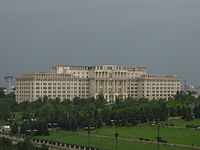- Centrul Civic
-
 The Romanian Academy building. Centrul Civic architecture bears a distinctive North Korean influence[1]
The Romanian Academy building. Centrul Civic architecture bears a distinctive North Korean influence[1]
Centrul Civic (literally "the Civic Center") is a district in central Bucharest, Romania, which was completely rebuilt in the 1980s as part of the scheme of systematization under the dictator Nicolae Ceauşescu.
Bucharest had taken significant damage due to Allied bombing during World War II and the earthquake of March 4, 1977. However, neither of these events changed the face of the city as much as the redevelopment schemes of the 1980s, under which eight square kilometers in the historic center of Bucharest were leveled, including monasteries, churches, synagogues, a hospital, and a noted Art Deco sports stadium. This also involved evicting 40,000 people with only a single day's notice and relocating them to new homes, in order to make way for the grandiose Centrul Civic and the House of the Republic, now officially renamed as the Palace of Parliament.
Centrul Civic is a complex of modern concrete buildings with marble façades, centered on a boulevard originally known as the Boulevard of the Victory of Socialism, renamed after the Romanian Revolution of 1989 as Union ("Unirii") Boulevard. The Boulevard, modeled after Paris's Champs-Élysées and a few meters wider than it, runs roughly east-west, constituting a grand approach to the Palace of the People at its western terminus. A grand balcony in the Palace surveys the entire length of the boulevard.
Centrul Civic includes numerous government offices and apartments, the latter being roughly equal in number to the housing units destroyed for its construction. The apartments were originally intended to house Romania's communist elite, but the completed complex is certainly not a preferred residence for the city's new capitalist elite, with the possible exception of buildings that look out on the now-bustling Unirea Square, where Centrul Civic bisects the Dâmboviţa River, which is channelled underground past the Square.
Centrul Civic stands out through its high degree of architectural uniformity, but also through its lack of commercial spaces. Most of the small shops and restaurants that form the heart of Bucharest are to be found in the areas immediately to the north of Centrul Civic.
The vast empty fields which emerged in the historic town during the demolitions of the 1980s were sarcastically called "Ceauşima" (a portmanteau of Ceauşescu and Hiroshima). Concrete hulks of half-completed buildings (such as the new National Library of Romania) stand where historic buildings (including much of the city's historic Jewish quarter) once stood. A remainder of the former "Ceauşima" is the never-completed eastern portion between Mircea Vodǎ and Nerva Traian streets (some 30 hectares).
Centrul Civic is surrounded on nearly all sides by historical buildings and neighborhoods. Lipscani, in particular, is one famous nearby street. Many churches, such as the Sf. Nicolai-Mihai Vodă Church, were moved rather than demolished, and the nearby Antim Monastery remains largely intact, although minus its eastern wing. Immediately adjacent to Centrul Civic, just off Unirii Square, is Dealul Mitropoliei, with the Patriarchal Cathedral and Palace, seat of patriarch of the Romanian Orthodox Church.
References
Geography of Bucharest, Romania Sectors of Bucharest Districts (quarters): Aviaţiei • Băneasa • Berceni • Bucureştii Noi • Centrul Civic • Colentina • Cotroceni • Crângaşi • Dămăroaia • Dealul Spirii • Dorobanţi • Dristor • Drumul Taberei • Dudeşti • Ferentari • Floreasca • Ghencea • Giuleşti • Giurgiului • Griviţa • Iancului • Lipscani • Militari • Moşilor • Obor • Odăi • Olteniţei • Pantelimon • Pipera • Primăverii • Progresul • Rahova • Regie • Tei • Titan • Vitan • VăcăreştiSquares: Charles de Gaulle • Constituţiei • Revoluţiei • Romană • Rosetti • Unirii • University Square • Victory Square • Quito SquareMajor streets: Şoseaua Kiseleff • Lipscani • Bulevardul Magheru • Calea Moşilor • Bulevardul Unirii • Calea VictorieiHills: Rivers: Lakes: listParks and forests: Băneasa Forest (Codrii Vlăsiei) • Bordei Park • Botanical Garden • Carol Park • Cişmigiu Gardens • Giuleşti Park • Herăstrău Park • Grădina Icoanei • Tineretului Park • Vitan ParkSee also: Coordinates: 44°25′37.65″N 26°5′41.90″E / 44.427125°N 26.094972°E
Categories:- Districts of Bucharest
Wikimedia Foundation. 2010.

